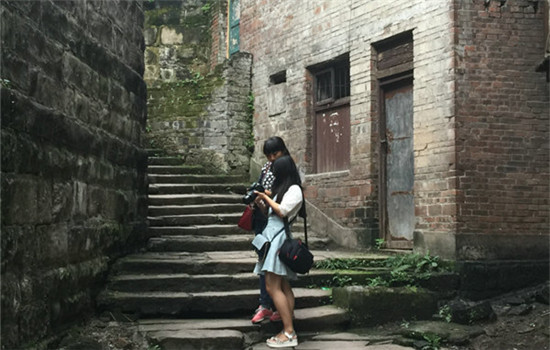
Xiahao Old Street is a historical residential block on the south bank of the Yangtze River in Chongqing. (Photo by Tan Yingzi/China Daily)
Climbing the stone steps by a hotpot restaurant onto the bustling Nanbin Road, walking up the hill for five minutes felt like traveling back in time to a simpler era.
It was a sunny afternoon, with hardly any people walking about on the paved street. Only some cats and dogs were milling around. Though the traditional houses with gray tiled roofs were a bit tumbledown, the street was clean with lots of trees and lush plants.
Xiahao Old Street, now a tranquil and historical residential block on the south bank of the Yangtze River, has begun to draw people's attention as a place to go and reminisce about the past.
Chongqing, the mountainous metropolis by the Yangtze River in Southwest China, has long been famous for its unique landscape, stunning night views and spicy hotpots. Many tourists are amazed by the number of highrises in the downtown area and the pace of urbanization of this historic industrial place.
But the ancient city with over 3,000 years of history has many legacies that should not be forgotten.
Xiahao Old Street, which winds from the river port up to the foot of Nanshan Mountain, dates back to the Qiaolong Period (1736-95) of the Qing Dynasty (1644-1911). Thanks to a once-booming port businesses, Xiahao became one of the major business areas in Chongqing. Now it has the only remains of stilted wooden houses in the city.
In 1890 when Chongqing was forced to open its ports to foreign businesses, Xiahao witnessed the establishment there of many international companies.
During World War II, Chongqing was the wartime capital of China. Wuhan University was relocated to Xiahao. After the People's Republic of China was founded in 1949, more changed. The country's central bank, the People's Bank of China, used to operate in this area.
In the 1990s, when the port businesses in the south bank declined and then eventually closed down, Xiahao was left behind as many young people moved to the new urban areas.
Now only about 300 families still live in the block; most are senior citizens who refuse to leave their community.
But Xie Peisong is an exception. The young architect was born in Xiahao in 1983 and stayed with his parents in a six-floor building until 2003. He now lives in a high-end apartment nearby, but his heart still remains in Xiahao. Last year he and his cousin Xie Ranran, another architect, returned to the area, rented a ruined house by his former home and turned it into a quaint studio and teahouse called Xiao Guan-meaning in Chinese, a small place.
"When I heard that Xiahao Old Street was going to be pulled down soon, I decided to do something to keep it alive as long as possible," Xie Peisong says.
The house has a traditional East Sichuan style with Chuandou structure, a distinctive wooden frame to support the roof, a perfect model for Xie's transformation project.


















































